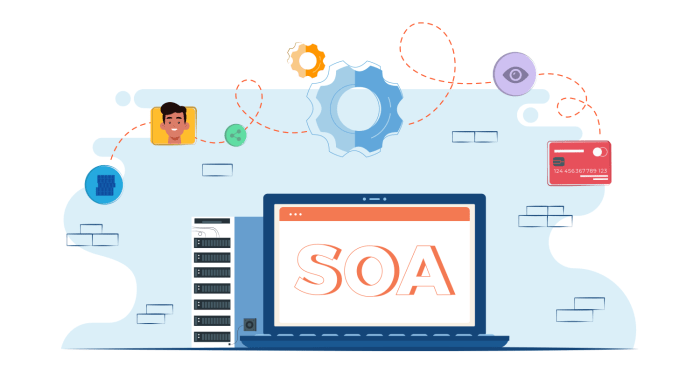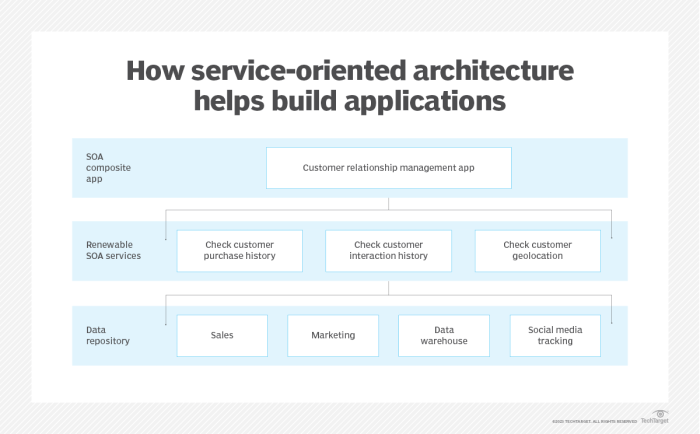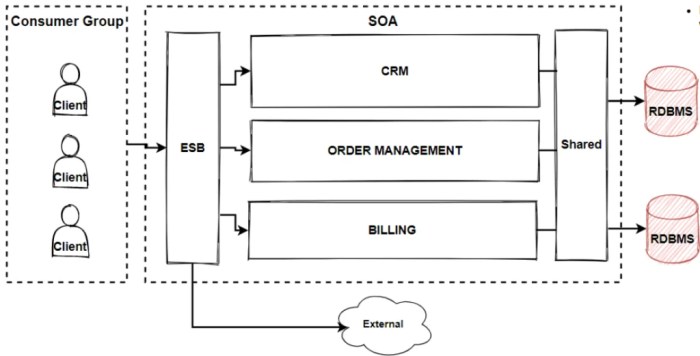Reuse is a benefit of service-oriented architecture because it supports the reuse of services across multiple applications, reducing development time and increasing efficiency. Organizations leveraging service reuse in SOA implementations have witnessed significant benefits.
Service-oriented architecture (SOA) enables the creation of reusable services that can be shared across multiple applications. This approach promotes code reuse, reduces development time, and improves overall efficiency. By leveraging SOA and service reuse, organizations can rapidly assemble new applications, leading to faster time-to-market and increased agility.
Reusability as a Key Benefit of Service-Oriented Architecture
Service-oriented architecture (SOA) enables the reuse of services across multiple applications. This is a key benefit of SOA, as it can significantly reduce development time and increase efficiency.
When services are reusable, they can be easily integrated into new applications, eliminating the need to re-develop the same functionality from scratch. This can save time and resources, and it can also help to ensure that applications are consistent and reliable.
There are many benefits to reusing services. For example, it can:
- Reduce development time
- Increase efficiency
- Improve application consistency
- Increase application reliability
Organizations have successfully leveraged service reuse in SOA implementations. For example, a large financial institution was able to reduce its development time by 50% by reusing services across multiple applications.
Principles and Practices for Effective Service Reuse

There are a number of principles and best practices that can be followed to ensure effective service reuse. These include:
- Service contracts:Service contracts define the interface and behavior of a service. They are essential for ensuring that services are used correctly and that they can be reused in a variety of applications.
- Loose coupling:Services should be loosely coupled, meaning that they are not dependent on each other. This makes it easier to reuse services in different applications and to update services without affecting other applications.
- Well-defined interfaces:Services should have well-defined interfaces. This makes it easier to understand how to use the service and to integrate it into applications.
- Service discovery:Service discovery is the process of finding and locating services. This is essential for reusing services, as it allows applications to find the services they need.
- Service composition:Service composition is the process of combining multiple services to create a new service. This can be a powerful way to reuse services and to create new applications.
Challenges and Considerations in Service Reuse

There are a number of challenges and considerations associated with service reuse. These include:
- Versioning:Services may need to be updated over time. This can create challenges for service reuse, as applications may need to be updated to use the new version of the service.
- Compatibility:Services may not be compatible with each other. This can make it difficult to reuse services in different applications.
- Security:Services need to be secure. This is especially important when services are reused in applications that are accessed by external users.
Organizations can overcome these challenges through proper planning and governance. For example, organizations can create a service registry to track the versions of services and to ensure that services are compatible with each other. Organizations can also implement security measures to protect services from unauthorized access.
Impact of Service Reuse on Application Development: Reuse Is A Benefit Of Service-oriented Architecture Because It Supports

Service reuse has a significant impact on the process of application development. By reusing services, developers can save time and resources, and they can also create applications that are more consistent and reliable.
SOA and service reuse enable the rapid assembly of new applications. This is because developers can simply reuse existing services to create new applications, rather than having to develop all of the functionality from scratch.
Service reuse also has implications for software architecture, design patterns, and testing strategies. For example, service reuse can lead to a more modular software architecture, which can make it easier to maintain and update applications.
Case Studies and Examples of Successful Service Reuse

There are many case studies and examples of successful service reuse implementations. For example:
- A large financial institution was able to reduce its development time by 50% by reusing services across multiple applications.
- A government agency was able to improve the efficiency of its customer service operations by reusing services to create a new customer portal.
- A healthcare provider was able to improve the quality of its patient care by reusing services to create a new patient management system.
These are just a few examples of how organizations have successfully leveraged service reuse to improve their operations and deliver value to their customers.
Detailed FAQs
What are the key benefits of service reuse in SOA?
Service reuse in SOA offers several key benefits, including reduced development time, increased efficiency, improved code quality, and enhanced maintainability.
How does SOA promote service reuse?
SOA promotes service reuse through the use of well-defined interfaces, loose coupling, and service contracts. These principles enable services to be easily integrated into different applications, fostering reuse and interoperability.
What are the challenges associated with service reuse?
Service reuse can present challenges such as versioning conflicts, compatibility issues, and security concerns. However, these challenges can be overcome through proper planning, governance, and the adoption of best practices.